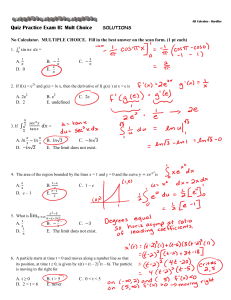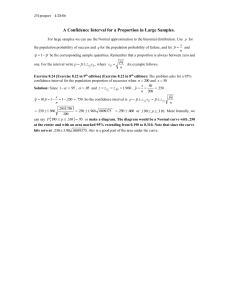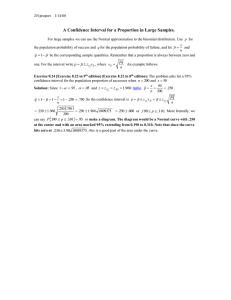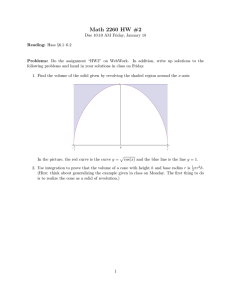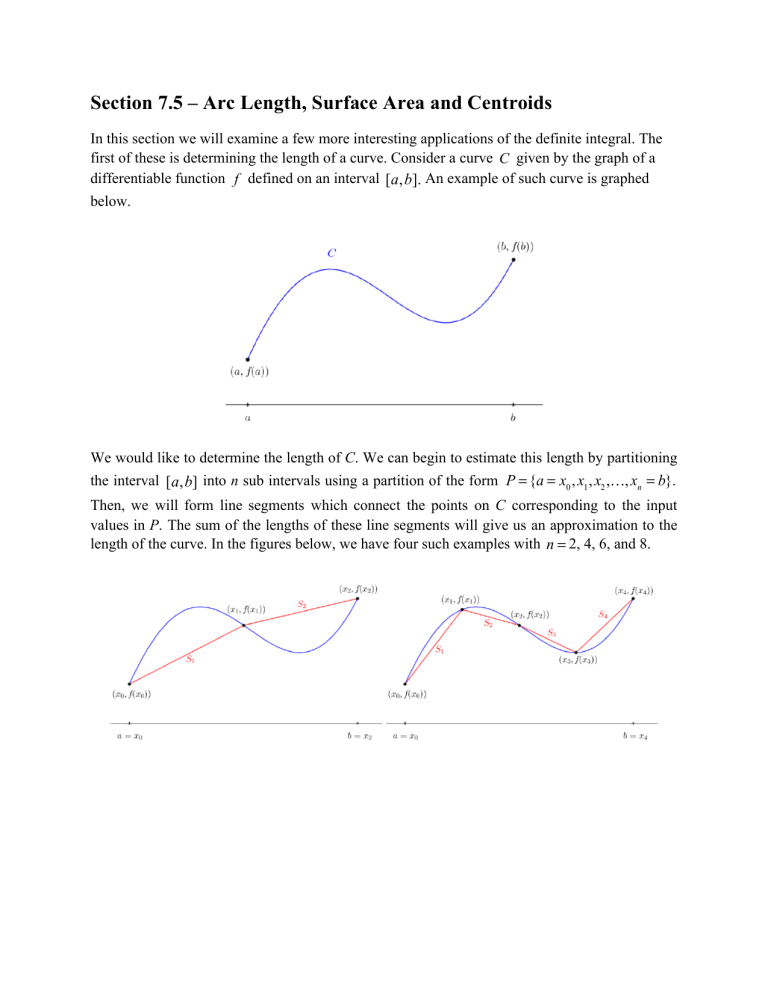
Section 7.5 – Arc Length, Surface Area and Centroids
In this section we will examine a few more interesting applications of the definite integral. The
first of these is determining the length of a curve. Consider a curve C given by the graph of a
differentiable function f defined on an interval [ a, b]. An example of such curve is graphed
below.
We would like to determine the length of C. We can begin to estimate this length by partitioning
the interval [a, b] into n sub intervals using a partition of the form P = {a = x0 , x1 , x2 ,…, xn = b}.
Then, we will form line segments which connect the points on C corresponding to the input
values in P. The sum of the lengths of these line segments will give us an approximation to the
length of the curve. In the figures below, we have four such examples with n = 2, 4, 6, and 8.
It is clear that as n gets larger, our estimate will become more accurate. We will now determine
the length, denoted by li , of each line segment S i. The line segment S i connects the points
( xi−1, f ( xi−1)) and ( xi , f ( xi )). Thus, applying the formula for the distance between two points
gives:
li =
2
2
( xi − xi −1 ) + ( yi − yi −1 )
=
2
2
( xi − xi −1 ) + ( f ( xi ) − f (xi −1 ))
.
Let us consider the term f (xi ) − f ( xi −1 ), since the function f is continuous on each [ xi −1 , xi ]
( xi−1, xi ) ,
and differentiable on the corresponding open interval
the Mean-Value Theorem
(Theorem 4.2.3) tells us there exists some xi* ∈ ( xi −1, xi ) such that:
f ′ ( xi* ) =
f ( xi ) − f ( xi −1 )
.
xi − xi−1
( )
Thus f ( xi ) − f ( xi −1) = f ′ xi* ⋅ ( xi − xi −1 ). Now, letting Δxi = xi − xi −1 , we have:
li =
2
( xi − xi −1 ) + ( f (xi ) − f (xi −1 ))
=
( Δxi )
2
=
( Δxi )
2
+ f ′ ( xi* ) ⋅ Δ xi
(
)
(
)
1 + ⎡ f ′ ( xi* ) ⎤
⎣
⎦
2
2
2
2
= Δxi 1 + ⎡⎣ f ′ ( xi* ) ⎤⎦ .
Letting Ln denote the sum of our n lengths, li , we estimate the length of the curve C to be:
n
2
n
2
Ln = ∑ Δxi 1 + ⎡⎣ f ′ ( xi* )⎤⎦ = ∑ 1 + ⎡⎣ f ′ ( xi* )⎤⎦ ⋅ Δxi .
i =1
i =1
The actual length of the curve is found by taking the limit as n goes to infinity of our estimate
Ln . Therefore, the length is:
n
2
L(C ) = lim L n = lim ∑ 1 + ⎡⎣ f ′( x i* ) ⎤⎦ ⋅ Δx i.
n→∞
n→∞
i =1
Notice that taking n to infinity is the same as taking Δxi to 0. Thus, by the definition of the
definite integral, we can see that:
n
2
L(C ) = lim ∑ 1 + ⎡⎣ f ′( x *i ) ⎤⎦ ⋅ Δx i =
n→∞
i=1
b
∫
2
1 + [ f ′( x) ] dx.
a
Putting this all together gives the following result.
Fact: Given a continuous function f defined on an interval [a, b], the length of the curve C
formed by the graph of f is given by:
b
L(C ) = ∫ 1 + [ f ′( x) ] dx.
2
(7.5.1)
a
Example 1: Find the length of the curve C given by the graph of the function f ( x ) =
2 32
x on the
3
interval [ 0,3] .
Solution: In order to use formula (7.5.1), we must first find f ′( x ). This gives us:
2 3 1
f ′( x) = ⋅ x 2 = x.
3 2
Thus, we find the integrand in formula (7.5.1) is:
2
2
1 + [ f ′( x) ] = 1 + ⎡ x ⎤ = 1 + x.
⎣ ⎦
Therefore the length of the curve would be:
3
L(C ) = ∫ 1 + xdx.
0
Let us now perform a u-substitution to evaluate this integral. Set u = 1 + x, which gives du = dx.
Also, when x = 0 we have u = 1, while x = 3 gives u = 4. Now, we can write:
1
L(C ) = ∫ 1 + xdx =
0
4
4
1
2 34 2 3 3
2
14
udu = ∫ u 2 du = u 2 = ⎡4 2 −1 2 ⎤ = [8 −1 ] = .
⎦ 3
3 1 3⎣
3
1
∫
1
Example 2: Find the length of the curve C given by the graph of the function f ( x) = ln (sec( x) )
⎡ π⎤
on the interval ⎢ 0, ⎥ .
⎣ 4⎦
Solution: Once again we will be using (7.5.1) to find the length of this curve. As before, we must
first find f ′( x ), which is:
f ′( x) =
1
d
1
⋅ (sec( x) ) =
⋅sec( x) tan( x) = tan( x).
sec(x ) dx
sec(x )
2
This gives us 1 + [ f ′( x) ] = 1+ tan 2 ( x) = sec 2 ( x). Thus, the integrand becomes:
2
1 + [ f ′( x) ] = sec2 ( x) = sec( x) .
On our interval, sec( x) > 0, which means sec( x) = sec( x). Hence, the length of the curve can
now be found to be:
π
4
L(C ) =
2
∫
1 + ⎡⎣ f ′( x ) ⎤⎦ dx
0
π
4
=
∫ sec( x ) dx
0
π
= ln sec( x ) + tan(x )
(
4
0
) (
= ln sec ( π4 ) + tan( π4 ) − ln sec ( 0)+ tan (0 )
(
= ln (
= ln
)
)
2 + 1) .
2 + 1 − ln (1 + 0)
Now that we know how to find the length of a curve C, we can turn our attention to finding the
surface area of a solid formed by revolving such a curve about an axis. To understand the basic
strategy, consider the simple example of a cylinder of radius r and height h. An example of such
a cylinder is shown below.
r
h
To find the area of this surface, we can make a vertical cut and lay the surface out flat to get a
rectangle, as below.
2π r
h
This gives a rectangle with area A = 2π r ⋅ h.
Let us return to the case of a curve C determined by the graph of a positive differentiable
function f defined on an interval [a, b], such as in the figure below:
Revolving this curve around the x-axis gives a surface S. This surface can be seen in the figure
below.
S
Our strategy for finding the surface area of S will be similar to the strategy for finding the arc
length of its generating curve C. We will once again partition the interval [a, b] into n subintervals using a partition of the form P = {a = x0 , x1 , x 2 ,…, xn = b}. We will also form line
segments approximating the curve C as before. Then we revolve the line segments about the xaxis and to form small bands whose surface area we can find. Finally, we add up all of these
areas to find our estimate. Four examples can be seen below with n = 2, 4, 6, and 8.
n=2
n=4
n=6
n=8
Once again, it is clear that as n tends to infinity, our red approximation will become more
accurate, and hence closer to the blue surface S. In the limit we will have the exact surface area.
Let Bi denote the small band created by revolving line segment S i around the x-axis. Recall: S i
connects the points ( xi −1, f ( xi −1)) and ( xi , f ( xi )). If we slice the band Bi and lay it flat as we did
the cylinder above, we get a trapezoid like the one shown below.
The area of this trapezoid is given by:
1
a i = (c i + c i−1 ) ⋅l i = π ( f (x i ) + f (x i−1 )) ⋅
2
2
( x i − x i−1 ) + ( f (x i ) − f (x i−1 ))
2
.
We established earlier that li can be written as:
2
li = 1+ ⎡⎣ f ′ ( xi* )⎤⎦ Δxi .
Additionally, since the function f is continuous and each interval [ xi −1, xi ] will be made small
by taking increasingly larger values of n, on each subinterval, we will have:
f ( xi− 1) ≈ f ( x*i ) and f ( xi ) ≈ f ( x*i ).
Thus, it will be the case that:
2
ai = π ( f ( xi ) + f (xi −1 ) ) ⋅ 1+ ⎡⎣ f ′ ( xi* )⎤⎦ Δxi
2
≈ π f ( x*i ) + f ( xi* ) ⋅ 1+ ⎡ f ′ ( xi* )⎤ Δxi
⎣
⎦
(
)
2
= 2π f ( x*i ) ⋅ 1 + ⎡⎣ f ′ ( xi* ) ⎦⎤ Δx .
(
)
Now we will define An as follows:
n
2
An = ∑ 2 π f ( xi* ) ⋅ 1 + ⎡⎣ f ′ ( xi* )⎤⎦ Δx.
i =1
(
)
As in the case of finding formula (7.5.1) we invoke the definition of the definite integral to find:
n
b
2
A( S ) = lim An = lim ∑ 2 π f ( x*i ) ⋅ 1 + ⎡⎣ f ′ (x*i )⎤⎦ Δx = ∫2 π f ( x) 1 + [ f ′( x) ] dx.
n →∞
n →∞
i =1
(
)
2
a
This brings us to the following two results.
Fact: Given a positive, differentiable function f ( x) with continuous derivative defined on an
interval [a, b], the area of the surface S obtained by revolving the graph of f around the x-axis
is given by:
b
A( S ) = ∫ 2π f ( x) 1 + [ f ′( x) ] dx.
2
(7.5.2)
a
Fact: Given a positive, differentiable function F ( y ) with continuous derivative defined on an
interval [c, d ], the area of the surface S obtained by revolving the graph of F around the y-axis
is given by:
d
2
A( S ) = ∫ 2π F ( y) 1 + [F ′( y) ] dy.
(7.5.3)
c
Example 3: Show that the surface area of a sphere with radius r is A = 4π r 2 by revolving the
semicircle of radius r, given by the graph of f ( x) = r 2 − x 2 with x ∈ [−r , r ], around the x-axis.
Solution: Below, we have graphs of the function f as well as the sphere formed by revolving
around the x-axis.
In order to apply formula (7.5.2), we must first find the derivative of the function f . This gives:
f ′( x ) =
d
1
d 2 2
1
−x
r 2− x 2 =
r −x =
.
⋅
−2x ) =
(
2
2
2
2
dx
2 r − x dx
2 r −x
r 2 − x2
(
)
Now we have:
2
⎡ −x ⎤
x2
r 2 − x2
x2
r 2 − x 2 + x2
r2
1 + [ f ′( x) ] = 1 + ⎢
1
.
=
+
=
+
=
=
⎥
2
2
2
2
2
2
2
2
2
2
2
2
r
x
r
x
r
x
r
x
r
x
−
−
−
−
−
r
x
−
⎣
⎦
2
Therefore we find:
2
1 + [ f ′( x) ] =
r2
r
=
.
2
2
2
r −x
r − x2
This means formula (7.5.2) gives:
r
A=
∫ 2π f (x ) 1+ [ f ′ (x )] dx =
2
−r
r
r
∫ 2π
−r
r
r 2 − x2
r
= ∫ 2π rdx = 2π r ∫ dx = 2π r ⋅ x
−r
r2 − x2 ⋅
−r
= 2π r ( 2r ) = 4π r 2 .
We have now established the desired formula.
r
−r
= 2π r (r − ( −r ))
dx
The last application we will examine in this section is finding the centroid (or geometric center)
( x , y ) of a region Ω in the plane given by the graph of a positive continuous function f on the
interval where x ∈ [a, b]. An example of such a region can be seen in the figure below.
Let us first examine the x coordinate x of this special point. This is just the weighted average of
the x values of all of the points in the region Ω, where the weight of each x is given by:
f (x )
.
A
Here A is the area of the region Ω. Recall the integral can be thought of as a continuous sum. So,
we find:
b
x =∫ x ⋅
a
f ( x)
dx.
A
A nicer way to write this is:
b
xA = ∫ x ⋅ f (x )dx .
a
Likewise, y is the weighted average of the y values of all of the points in the region Ω. Note
that for a given x ∈ [a, b], the average y value is:
1
1
( f ( x) + 0 ) = f ( x).
2
2
Therefore, we find:
b
b
1
1
2
yA = ∫ f (x ) ⋅ f (x )dx = ∫ [ f (x ) ] dx.
2
2
a
a
We summarize with the following result.
Fact: Given a positive, continuous function f ( x) defined on an interval [a, b], the region Ω
bounded by the graph of f and the x-axis, of area A, has centroid ( x , y ) given by:
b
b
1
2
f (x )] dx .
[
2
a
xA = ∫ xf (x )dx and yA = ∫
a
(7.5.4)
It is worth mentioning (and an excellent check when one is finding a centroid) that for any such
region the centroid must satisfy a ≤ x ≤ b.
Example 4: Find the centroid of the region, Ω, beneath the graph of f ( x) = x on the interval
[0, 4].
Solution: We first find the area of Ω to be:
4
A = ∫ xdx =
0
3
2 32 4 2 ⎡ 32
2
16
x = 4 − 0 2 ⎤ = [8 − 0] = .
⎦ 3
3 0 3⎣
3
Now, formula (7.5.4) gives us:
4
4
3
5
16
2 54 2 5
2
64
x ⋅ = ∫ x xdx = ∫x 2 dx = x 2 = ⎡42 − 02 ⎤ = [ 32 − 0] =
.
⎦ 5
3 0
5 0 5⎣
5
0
So, x =
3 64 12
= . Also, by formula (7.5.4), we find:
16 5
5
4
y⋅
This means y =
4
2
16
1
1
1 1 4 1
= ∫ ⎡⎣ x ⎤⎦ dx = ∫ xdx = ⋅ x 2 = ⎡⎣ 42 − 02 ⎤⎦ = 4.
3 02
20
2 2 0 4
3
12 3
⋅ 4 = = . Therefore, the centroid of this region is
16
16 4
⎛12 3 ⎞
⎜ , ⎟.
⎝ 5 4⎠
The general case of (7.5.4), for general region in the plane is given below.
Fact: Suppose Ω, of area A, is defined by continuous functions f and g such that:
a ≤ x ≤ b and g ( x) ≤ y ≤ f (x).
Then Ω has centroid ( x , y ) given by:
b
b
1
2
a
xA = ∫ x [ f (x ) − g (x )] dx and yA = ∫
a
([ f (x )] − [g (x )] )dx .
2
2
(7.5.5)
Finally, having established the formulas necessary to find a centroid, we can state the following
powerful theorem.
Theorem 7.5.1: Pappus’s Theorem on Volumes:
Suppose a solid is created by revolving region Ω in the plane around any axis, such that Ω does
not cross this axis. Then the volume of the solid is given by:
V = 2π RA.
(7.5.6)
Here R is the distance from the centroid of Ω to the axis of revolution and A is the area of the
region Ω.
Example 5: Use Theorem 7.5.1 to find the volume of the solid formed by revolving the region in
example 4 around the x-axis.
16
⎛ 12 3 ⎞
Solution: We found the centroid of this region Ω to be ⎜ , ⎟ and the area to be A = . This
3
⎝ 5 4⎠
3
means R = y = . Thus, the volume of this region is given by:
4
3 16
V = 2π RA = 2π ⋅ ⋅ = 8π .
4 3
Recall that this agrees with the value of the volume found using the disk method in section 7.5.


